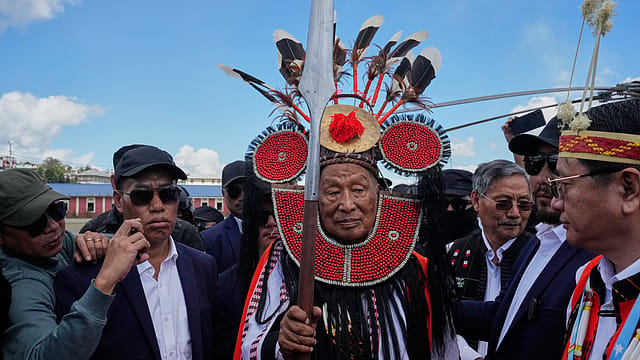Muivah Returns Home Empty-Handed

At 91 Thuingaleng Muivah is a legend among the Nagas. The general secretary of the National Socialist Council of Nagaland (NSCN IM) returned home to his village on Wednesday, 50 years after he left to wage war for a separate state of Nagaland.
He returned to a rousing welcome, one reserved for heroes, at Somdal, a picturesque village in Naga Hills area of Ukhrul district in Manipur. As could be expected, his village was proud of his “achievements” and welcomed him as a long-lost son.
But if one reviews the ledger of his life dispassionately, the pages are, unsurprisingly, empty. In his old age, the firebrand leader is bitter and, in a speech, written by him for the occasion he stressed the Naga “struggle” for “his people.”
Matters could have been wrapped soon after the Naga side signed a Framework Agreement with the Centre in August, 2015. Some of the sticking issues could have been easily wrapped up and accommodated within the framework of the Constitution of India. Article 371A of the Constitution gives wide-ranging autonomy in crucial matters such as religion, social practices, customary law and ownership and transfer of land. No Act of Parliament has force when it comes to these matters unless the legislative assembly of Nagaland passes an enabling resolution to that effect.
That, however, was not enough for Muivah and the NSCN (IM).
Lost: The Unstoppable Decline of Congress
05 Dec 2025 - Vol 04 | Issue 50
Serial defeats | Leadership in denial | Power struggles
The group wanted a separate flag and Constitution for Nagaland. Even after signing an agreement, these issues were raised repeatedly by the group. In 2020, the group publicly released the Framework Agreement in a bid to exert pressure on the Centre and its then interlocutor on negotiations with the Nagas.
Another “irritant” for the NSCN (IM) was the Centre’s efforts to rope in the so-called Naga National Political Groups (NNGP), a collection of organisations reflecting the political aspirations of the Nagas. Muivah and his group wanted exclusive control over the entire process of negotiations.
These issues led to an impasse.
Under no circumstances could the Centre agree to a separate flag and a Constitution for the Nagas. For one, it would negate more than 60 years of negotiations and efforts to arrive at a settlement in Nagaland. For another, these concessions would, de facto, declare that the Nagas are a separate nation. The path to Nagaland’s secession from India would then be just a few steps away. Finally, such a step would put a question-mark over the unity and integrity of India: If Nagaland could be given a flag and a Constitution, how could any state be denied that? This would lead to a spate of such demands—all unjustified—across the length and breadth of India.
That was not the end of the problems. The Naga leadership has long wanted to “unite” all Naga areas under one state: the so-called Nagalim. That is a fraught exercise. For one, it would destroy the unity of Manipur. That state has a history of ethnic conflicts and the Centre would be loath to add more fuel to fire. For another, if all-Naga areas are to be united, that would also mean the Naga areas of Myanmar, a step that would certainly create a diplomatic upheaval with a sensitive neighbouring country that has its own history of ethnic troubles.
OBDURACY DOESN’T PAY
There is a history of obduracy on the part of the Naga leadership right since the time of the Naga leader Phizo who was so rigid in his demands that no amount of persuasion and concessions short of secession could satisfy him. He ultimately died a forlorn figure in faraway London.
In War and Peace in Nagaland (1975), Y D Gundevia, who was India’s Foreign Secretary in 1965, highlighted the results of negotiations between the Government of India and the Naga leadership that year. In a series of meetings held at different locations in Nagaland, an earnest effort was made by the government to arrive at a settlement. But these efforts went nowhere. The Naga interlocutors were unwilling to discuss anything except separation from India. In the end, Gundevia gave up and openly stated in his memoirs that the Nagas were not ready for peace. Until 1972, Nagaland was under the administrative charge of the Ministry of External Affairs.
In 2027, it will be 80 years since the start of insurgency in Nagaland. The earliest application of the Armed Forces Special Powers Act (AFSPA) bears the signatures of India’s first President, Dr Rajendra Prasad, who signed an Ordinance applying those measures to the then Naga Hills District of Assam. In these eighty years, the Nagas have lost much and the country, too, has paid much in blood and treasure to preserve its integrity. The threat of Nagaland seceding from India is now rather low. Nagaland is a proud state and, like any other state, is progressing at its own pace. It would have been much better for the Nagas and India alike if the Nagas had a wiser leadership.
